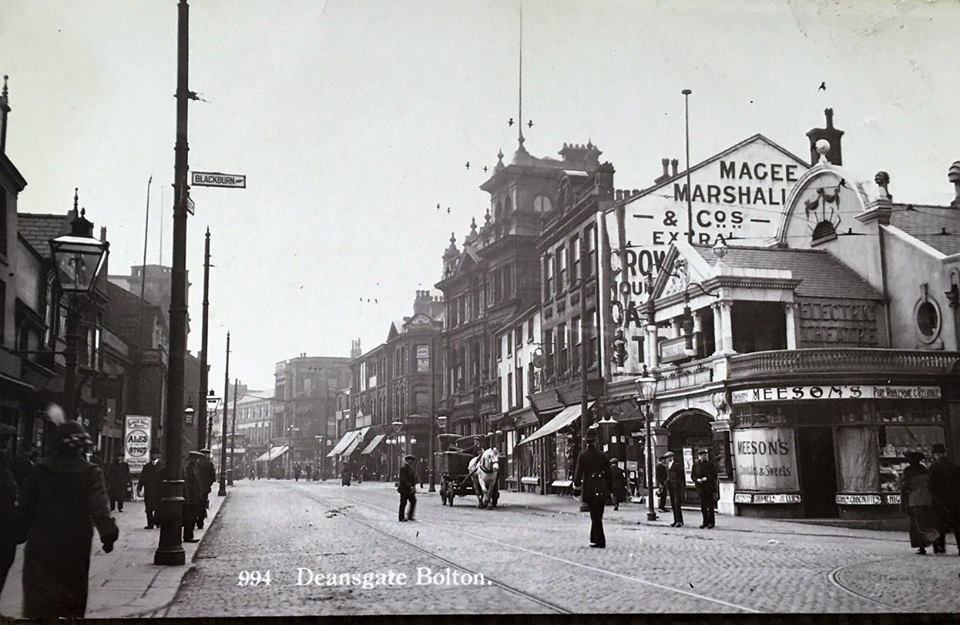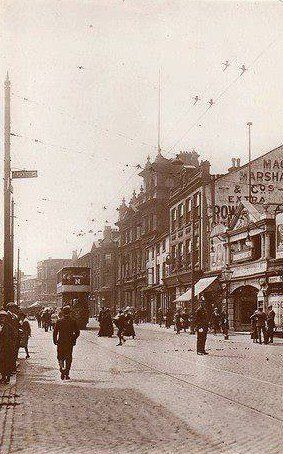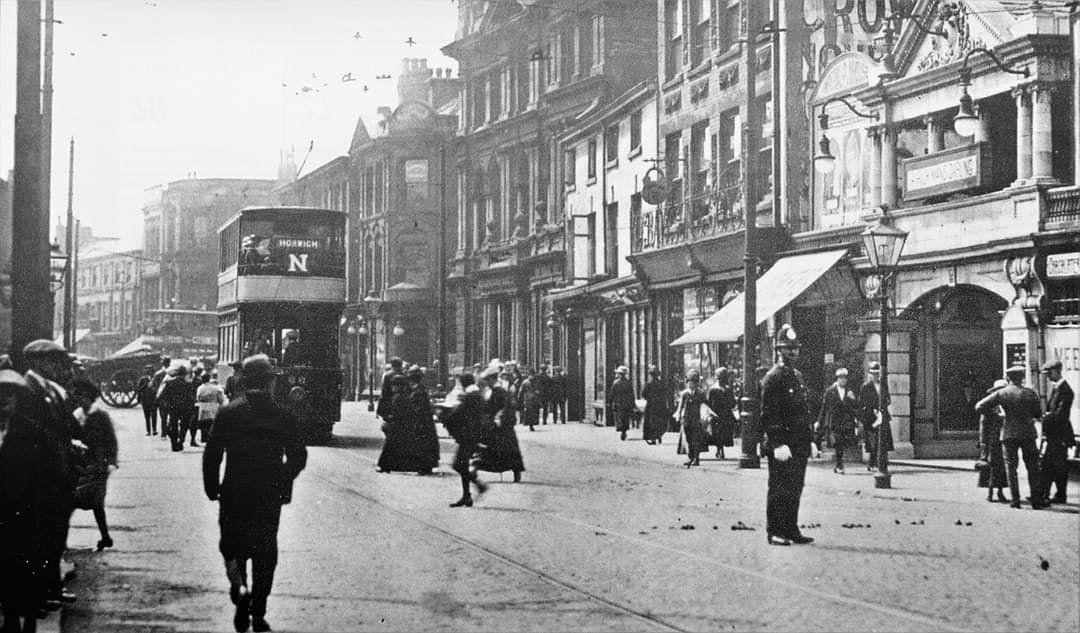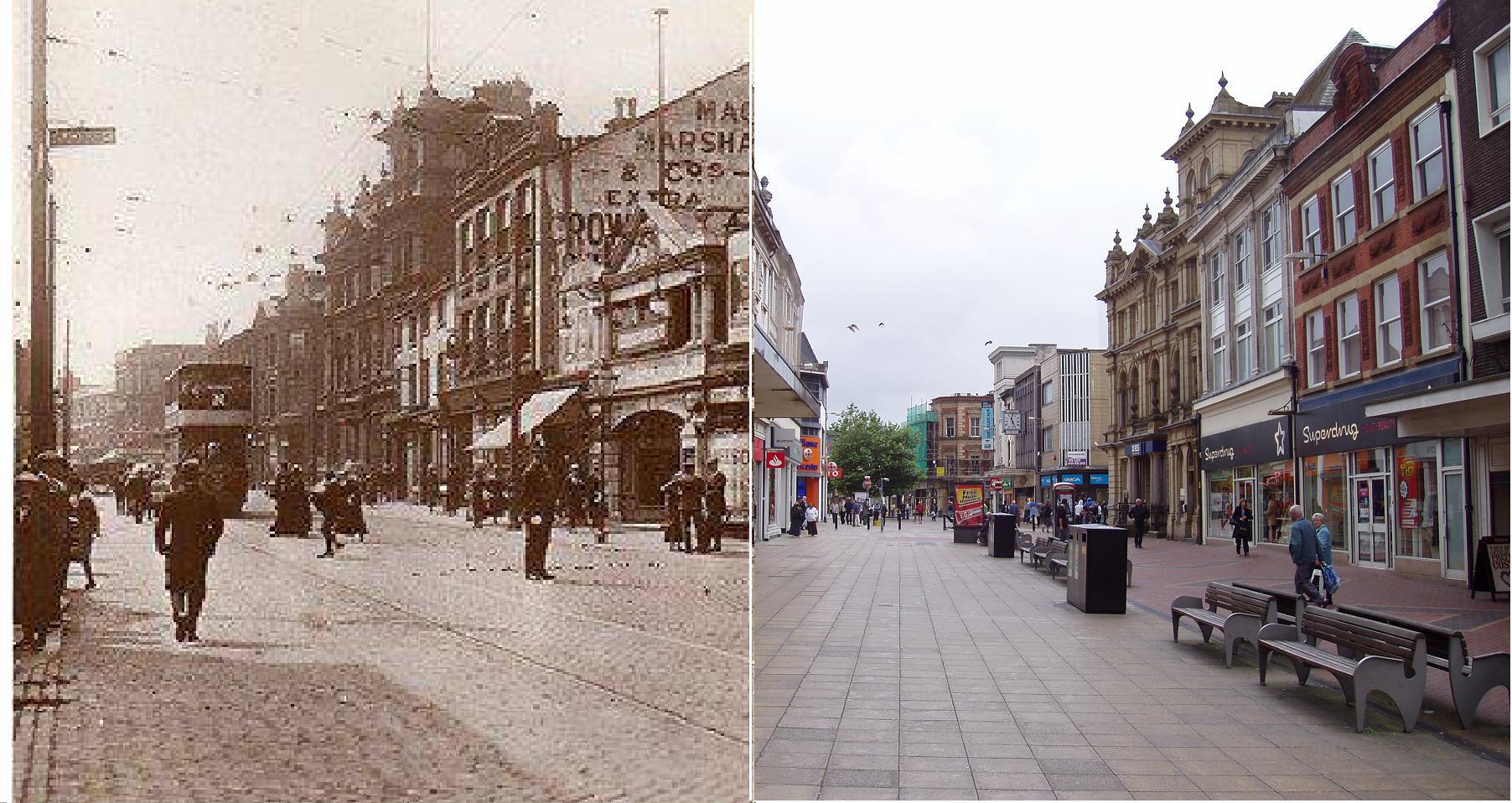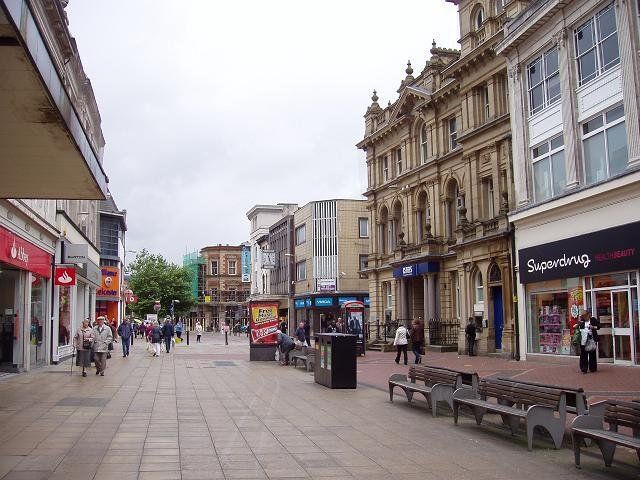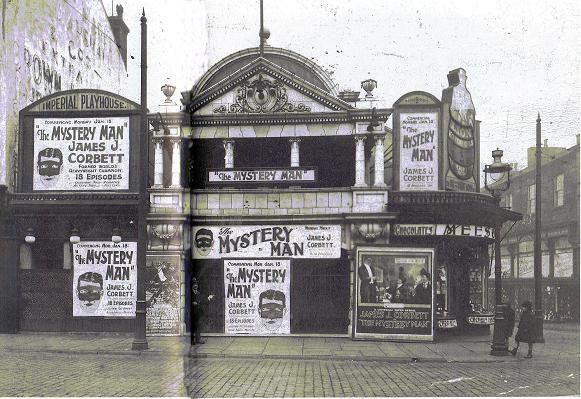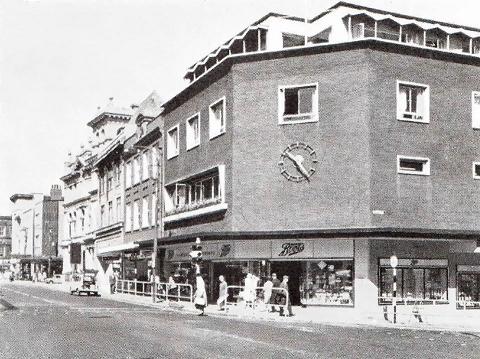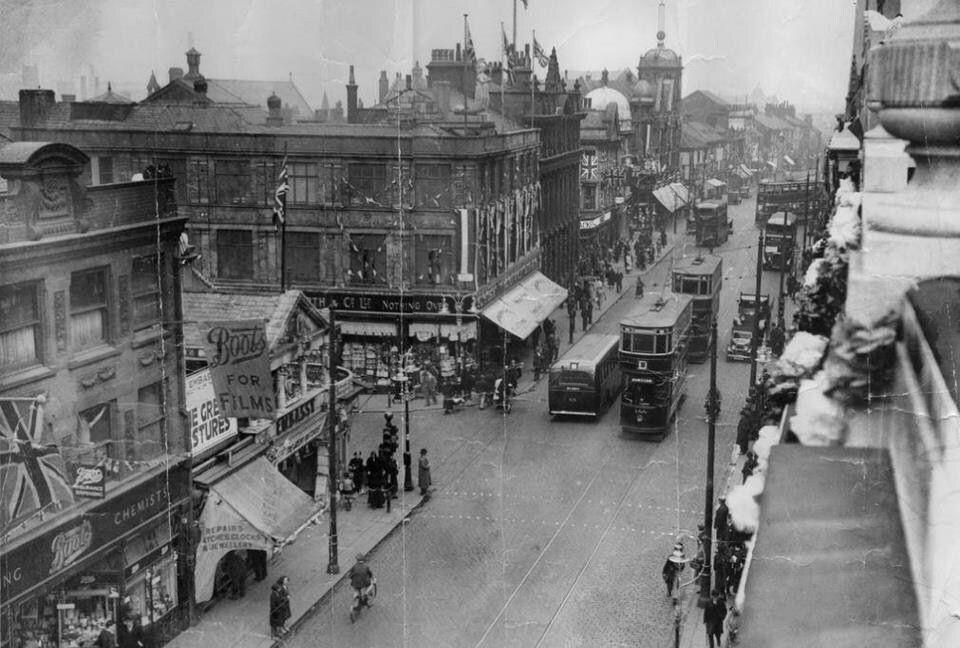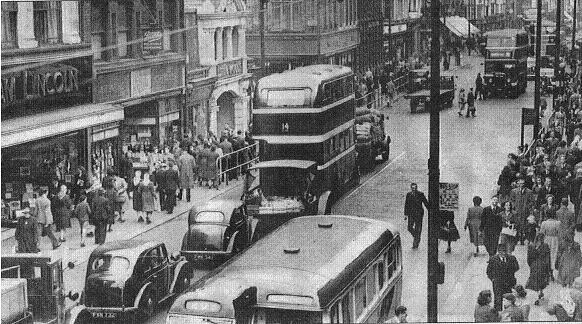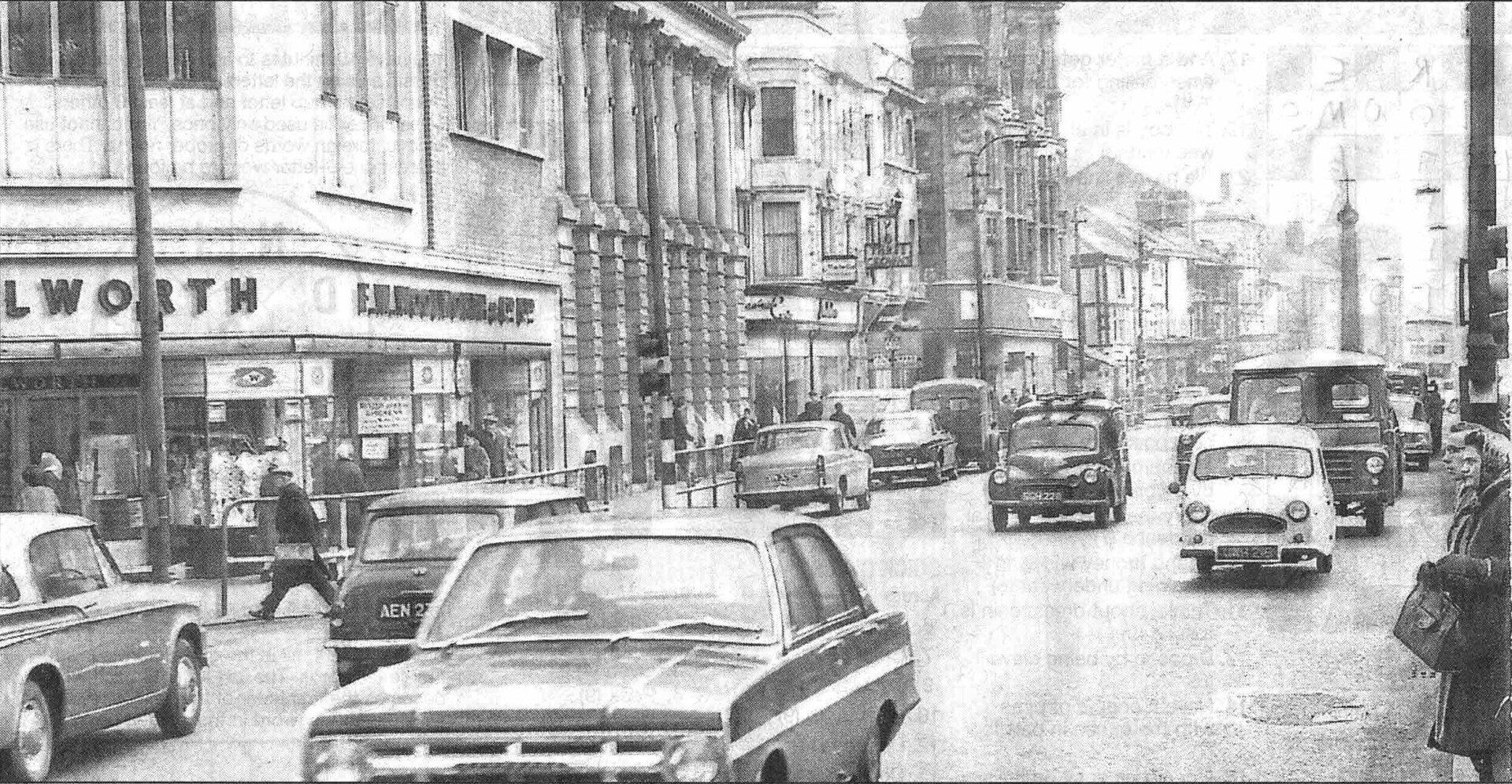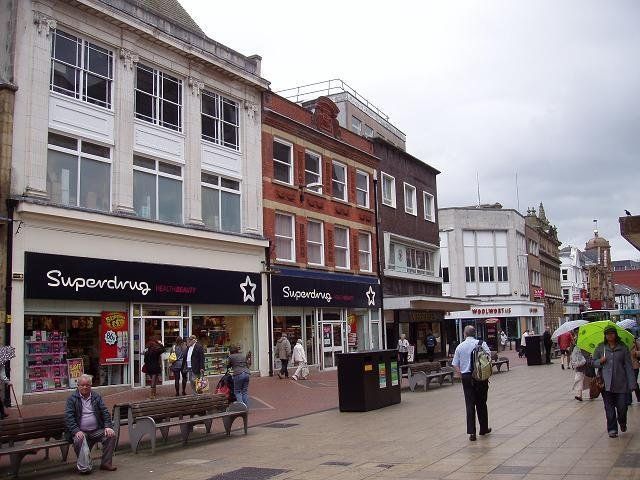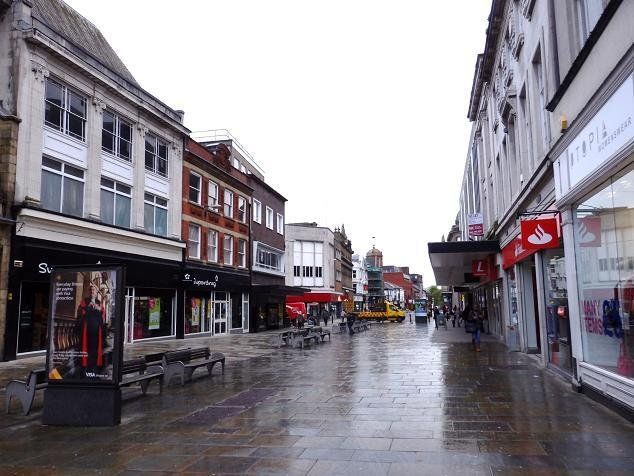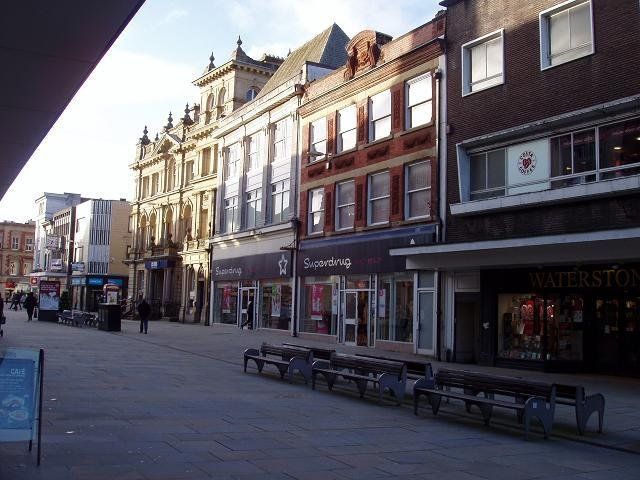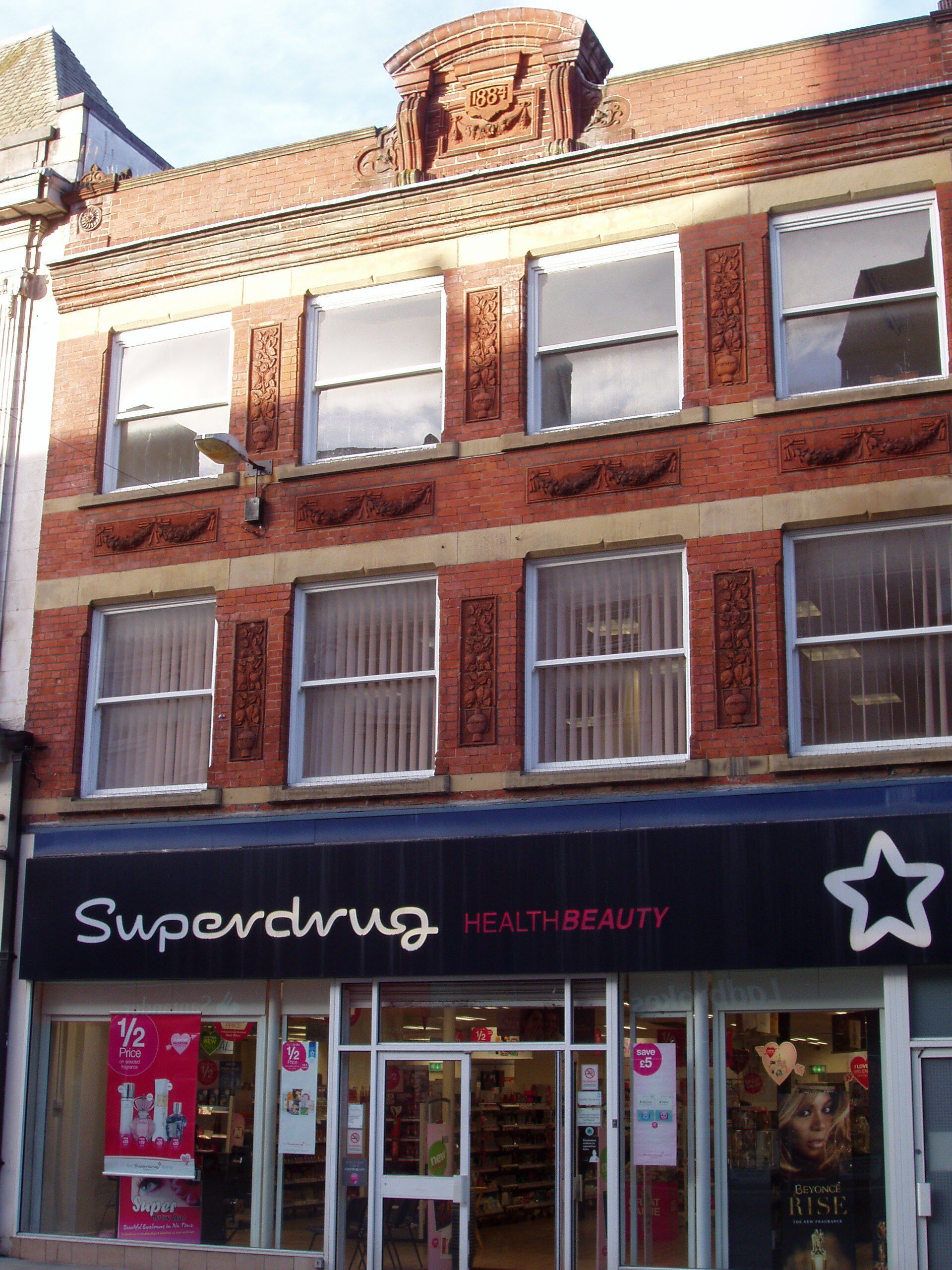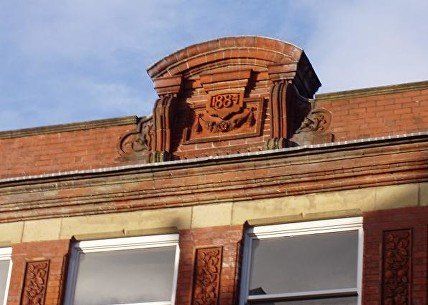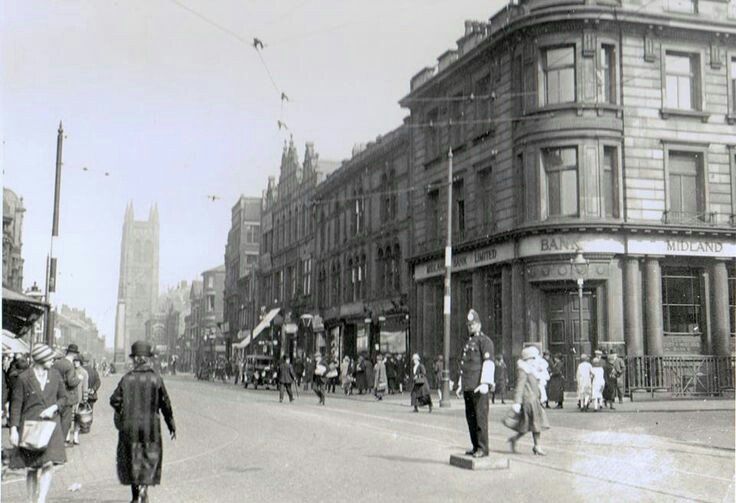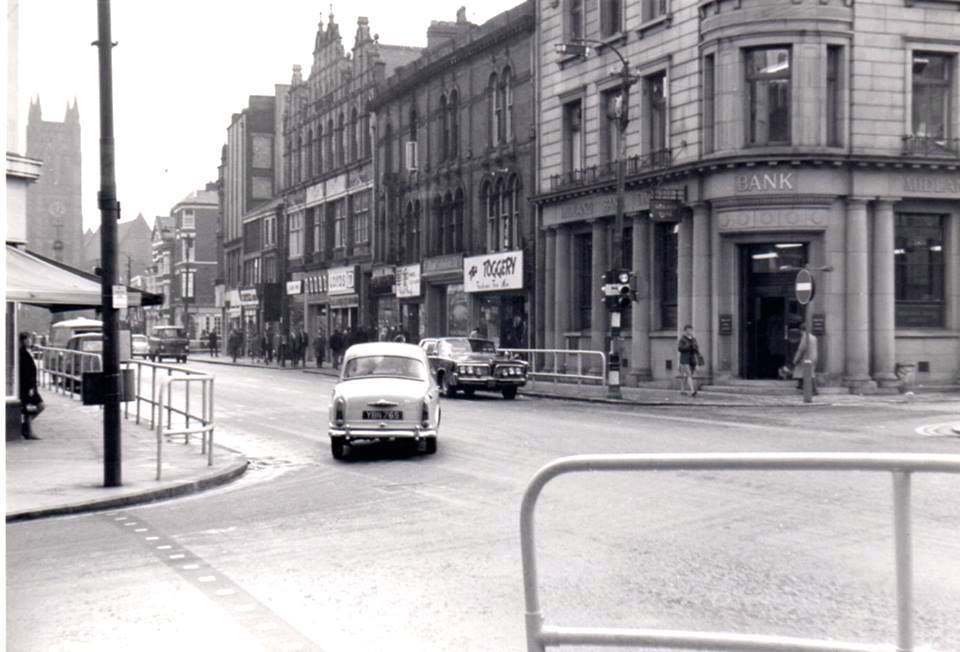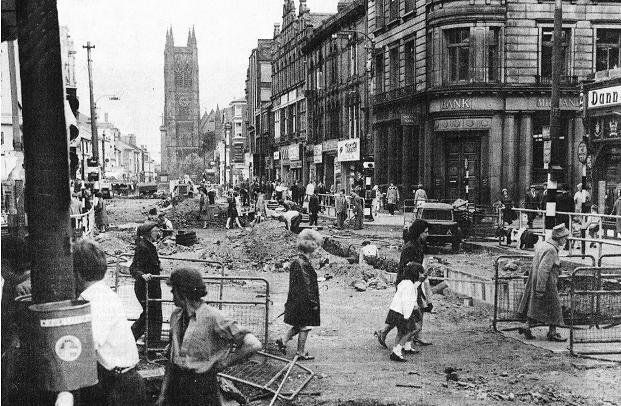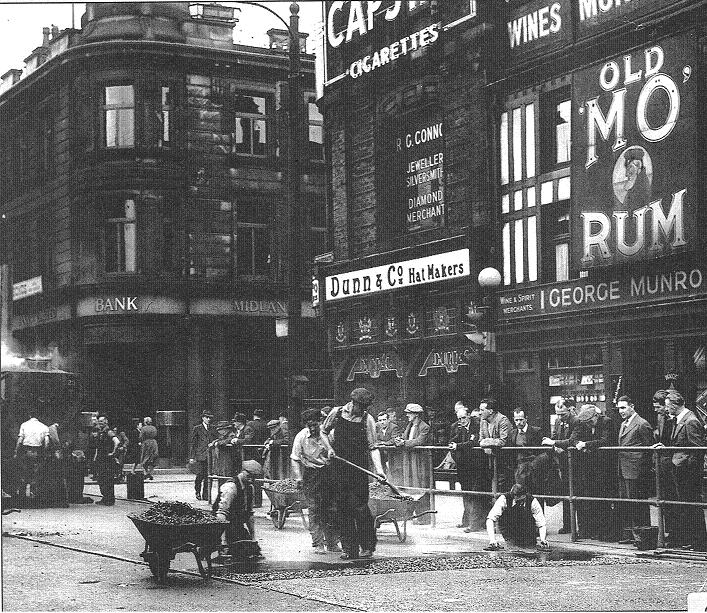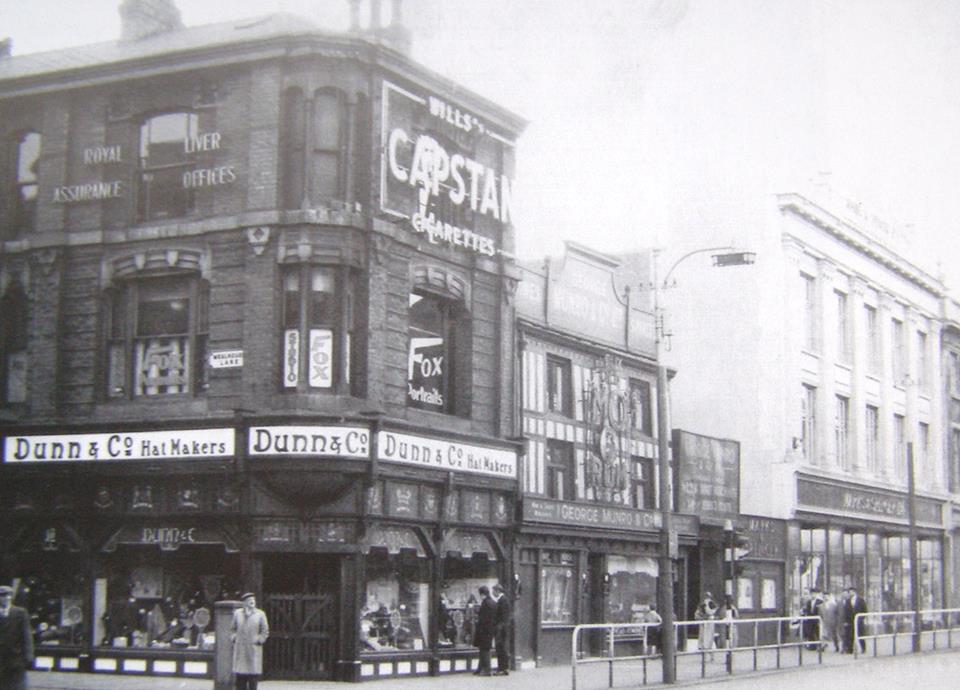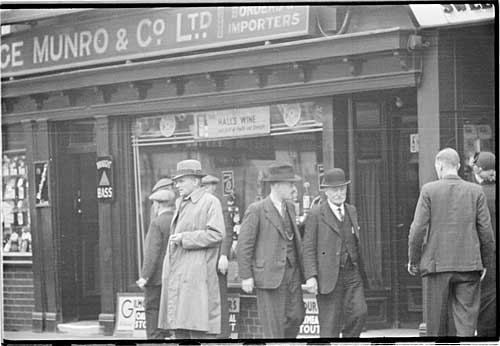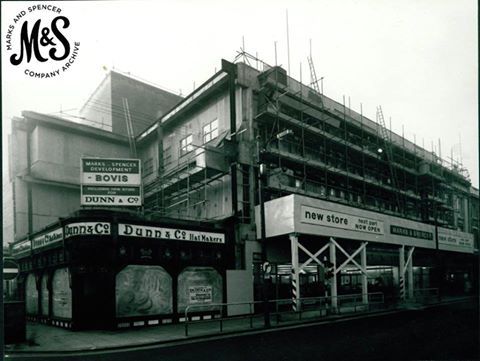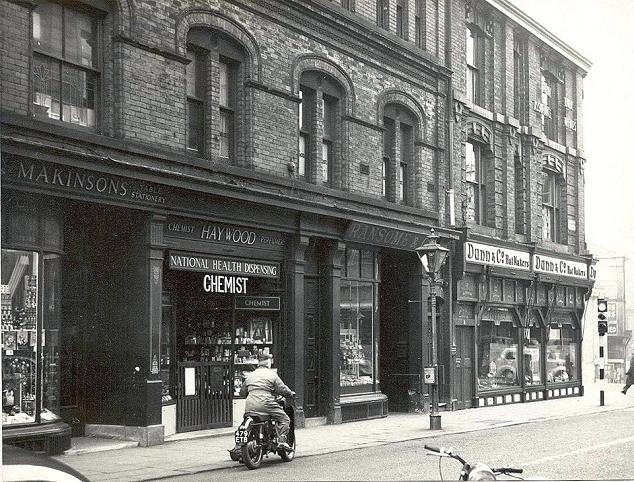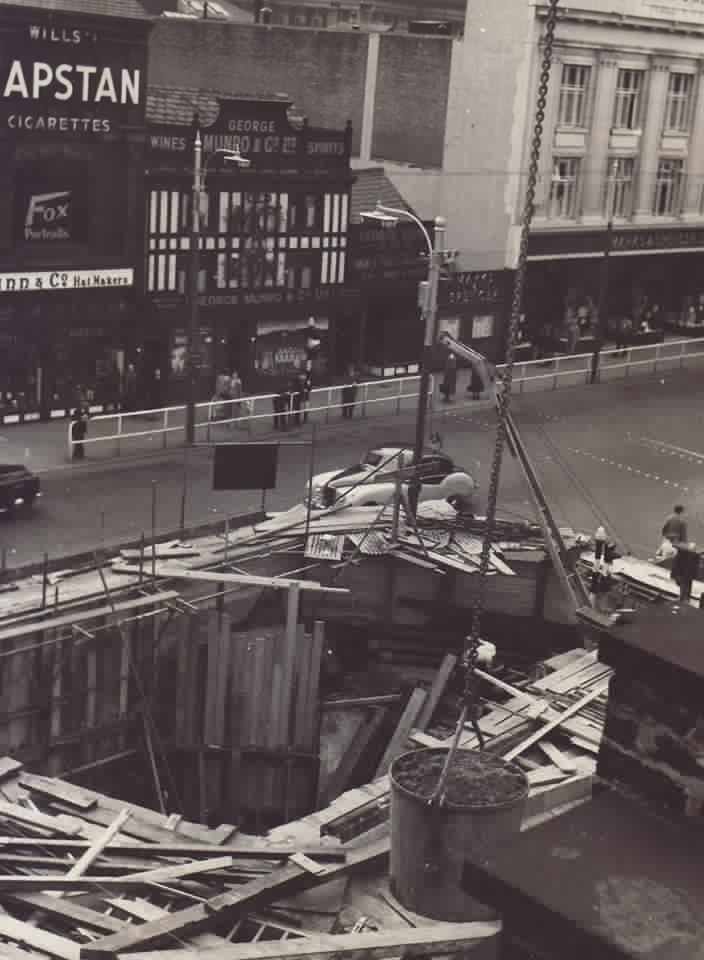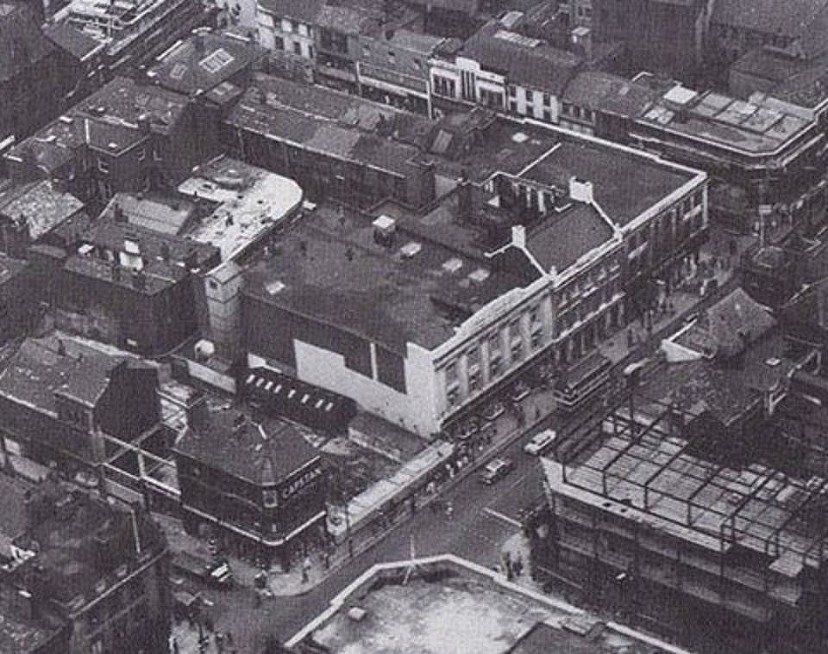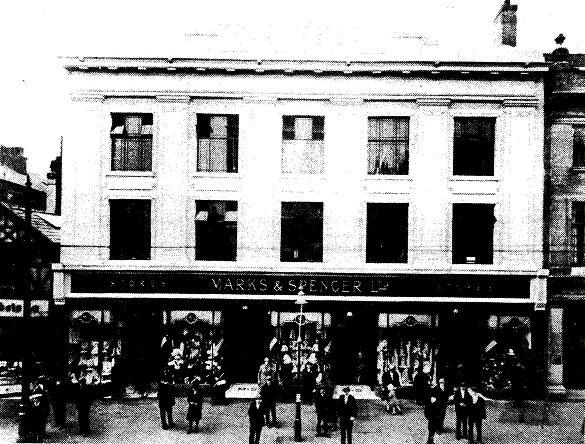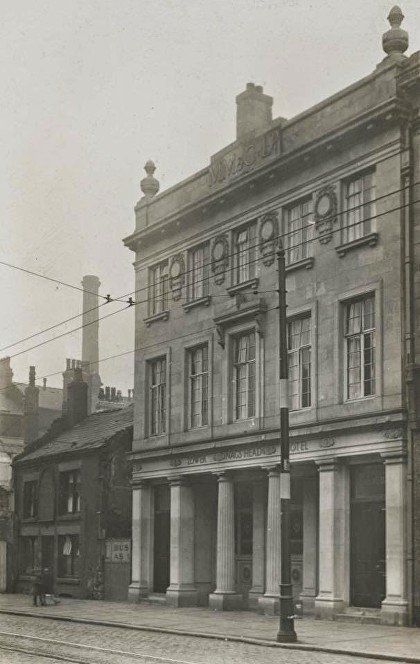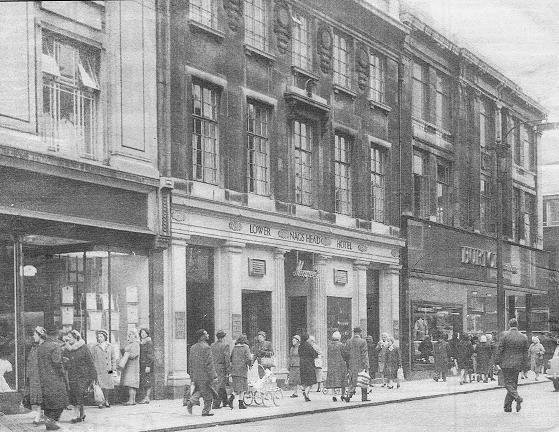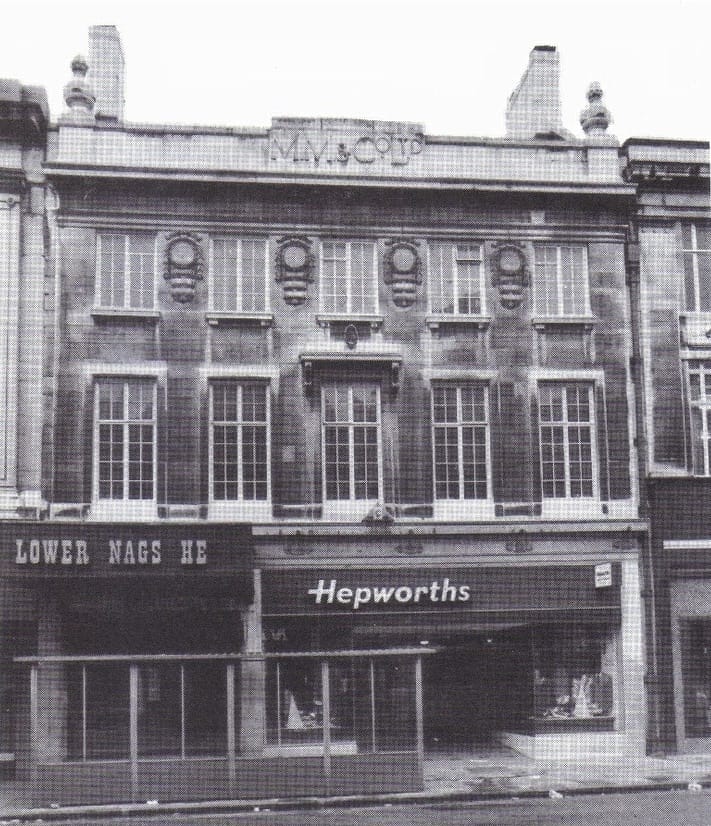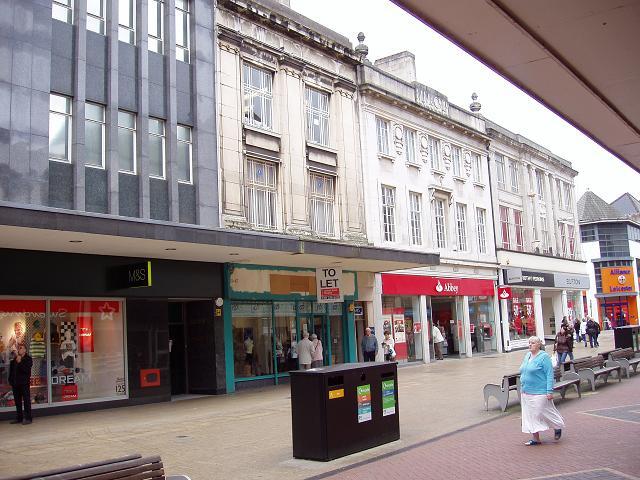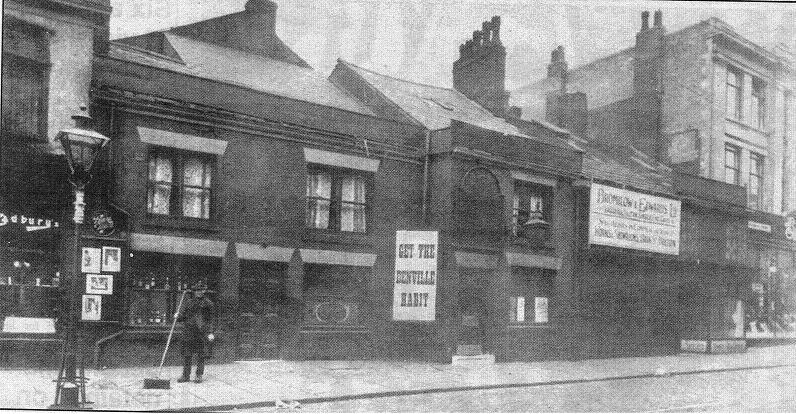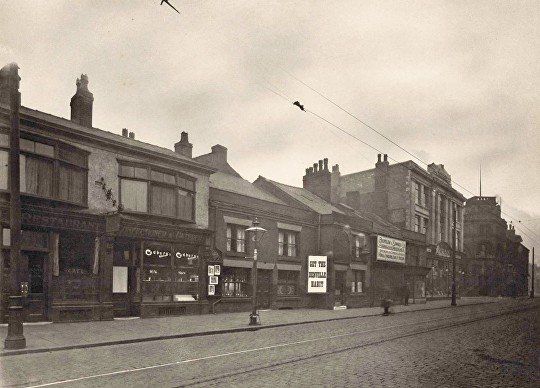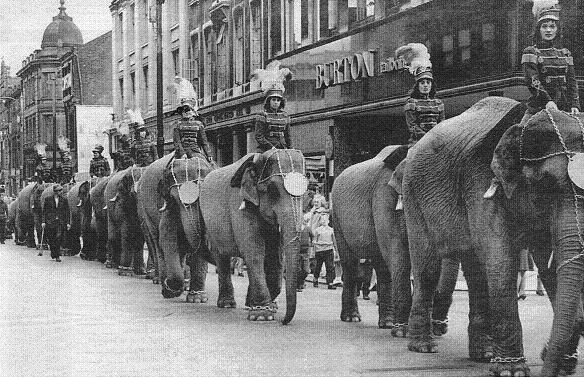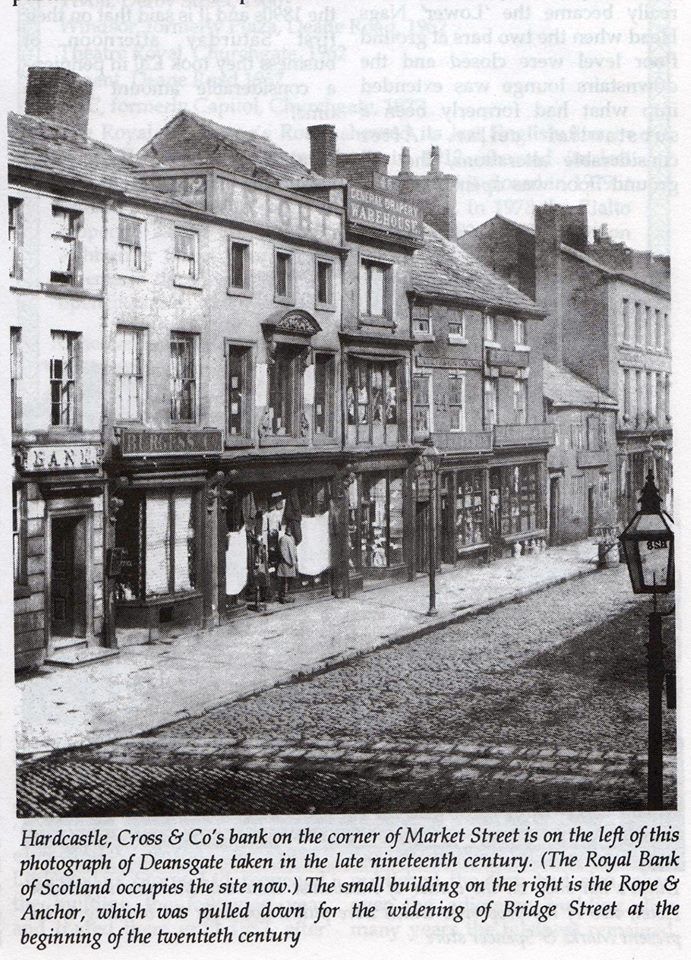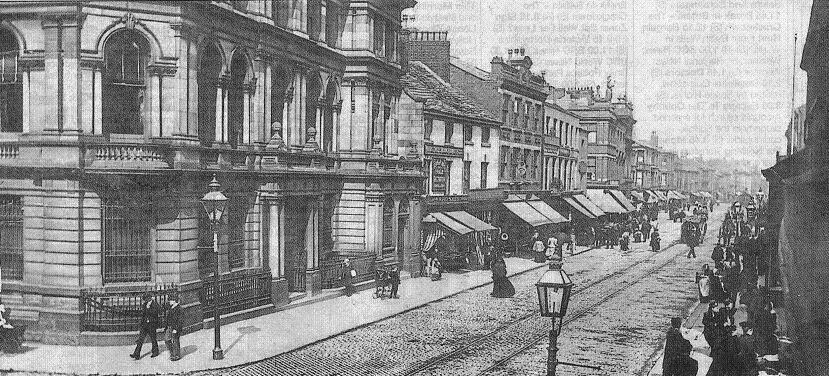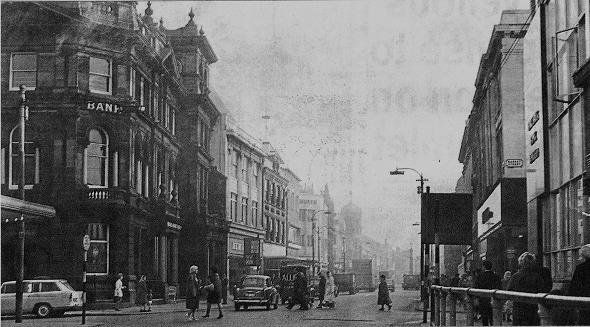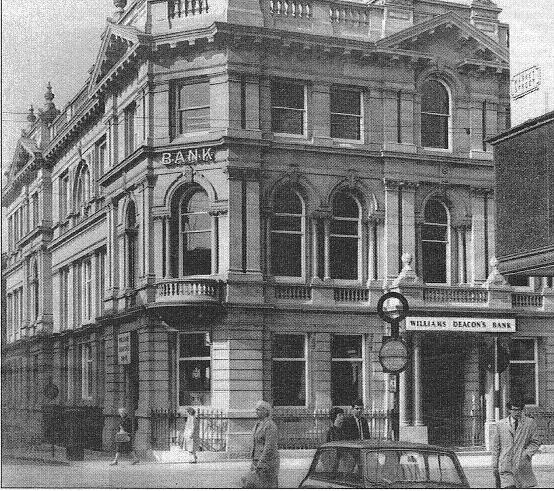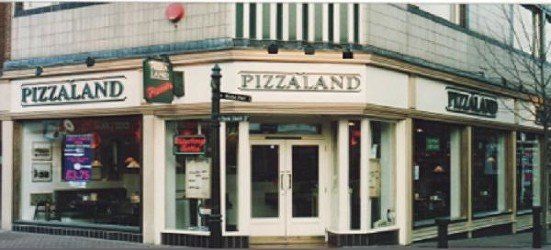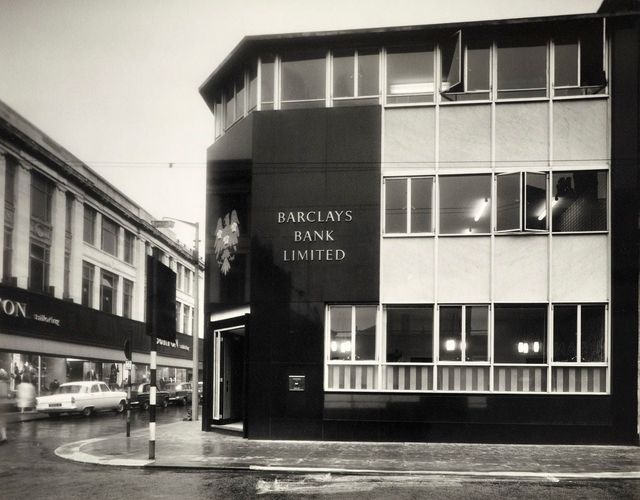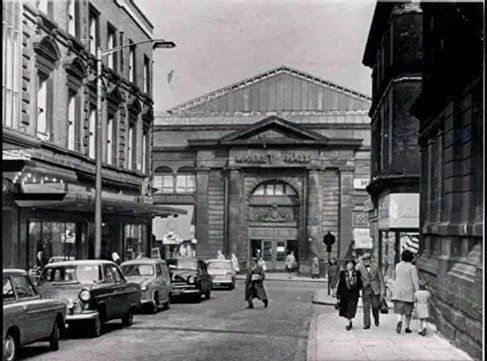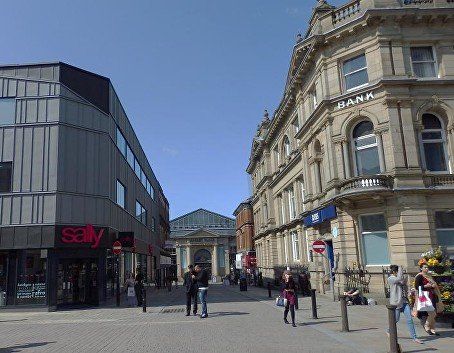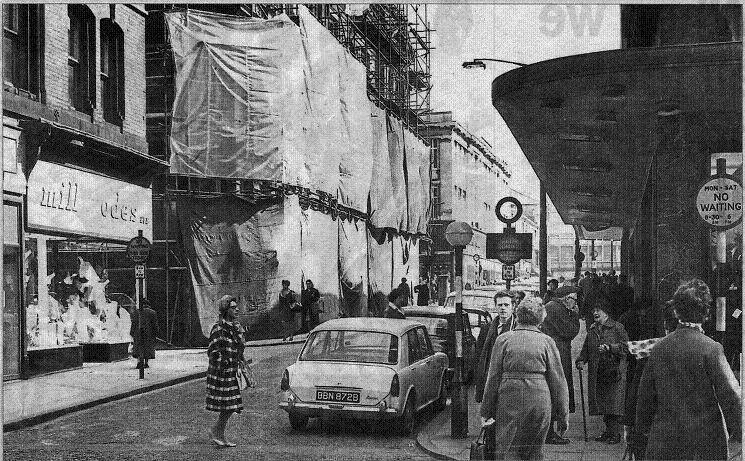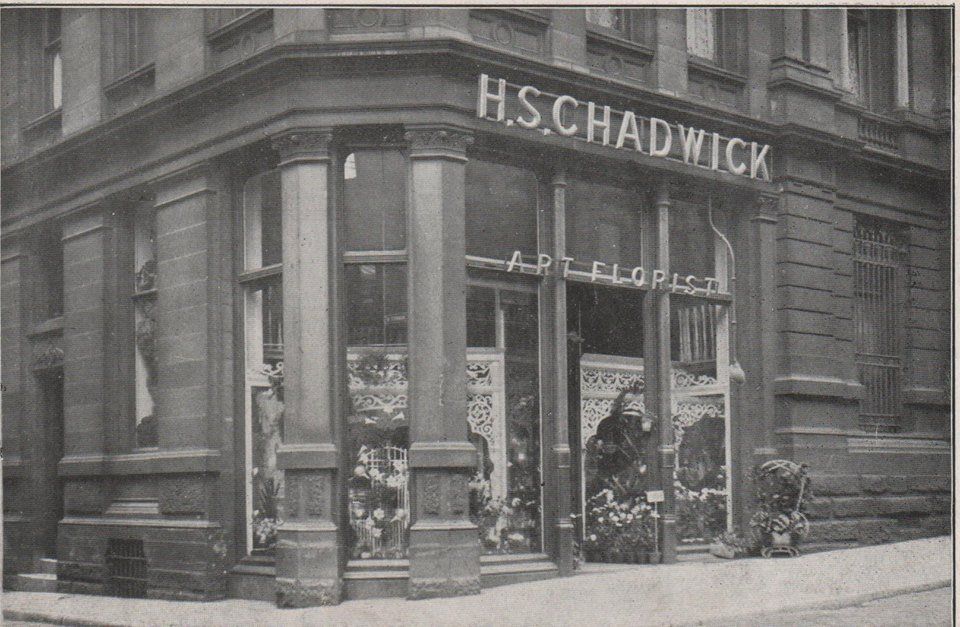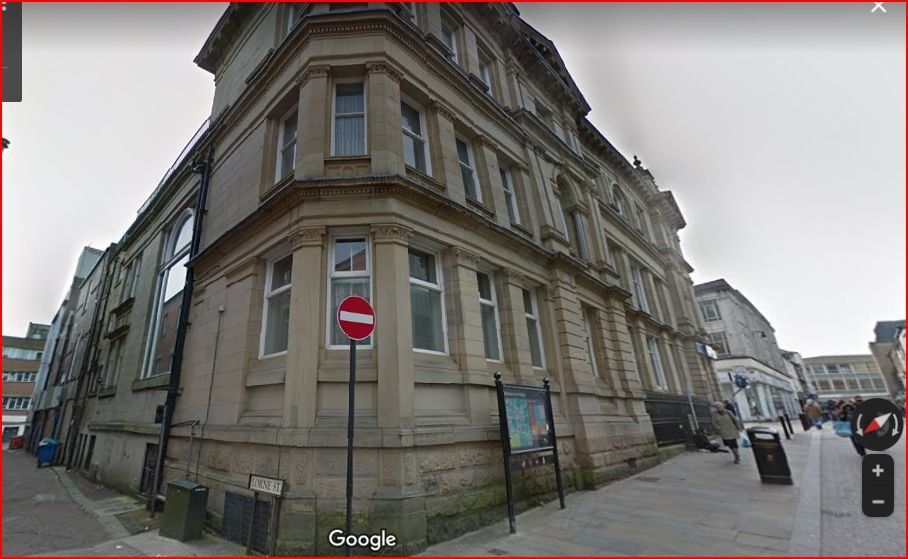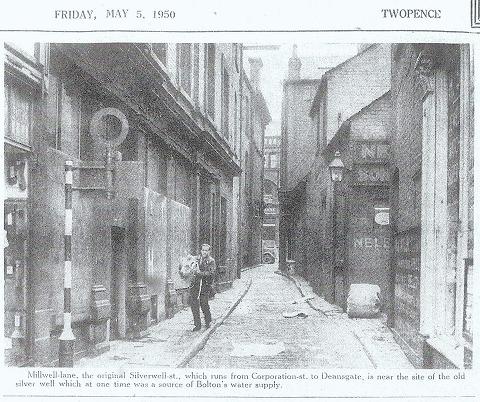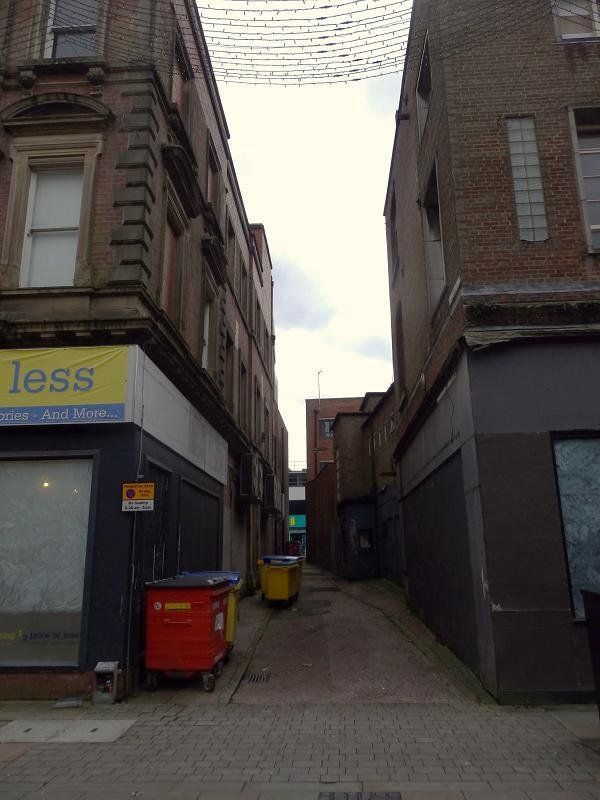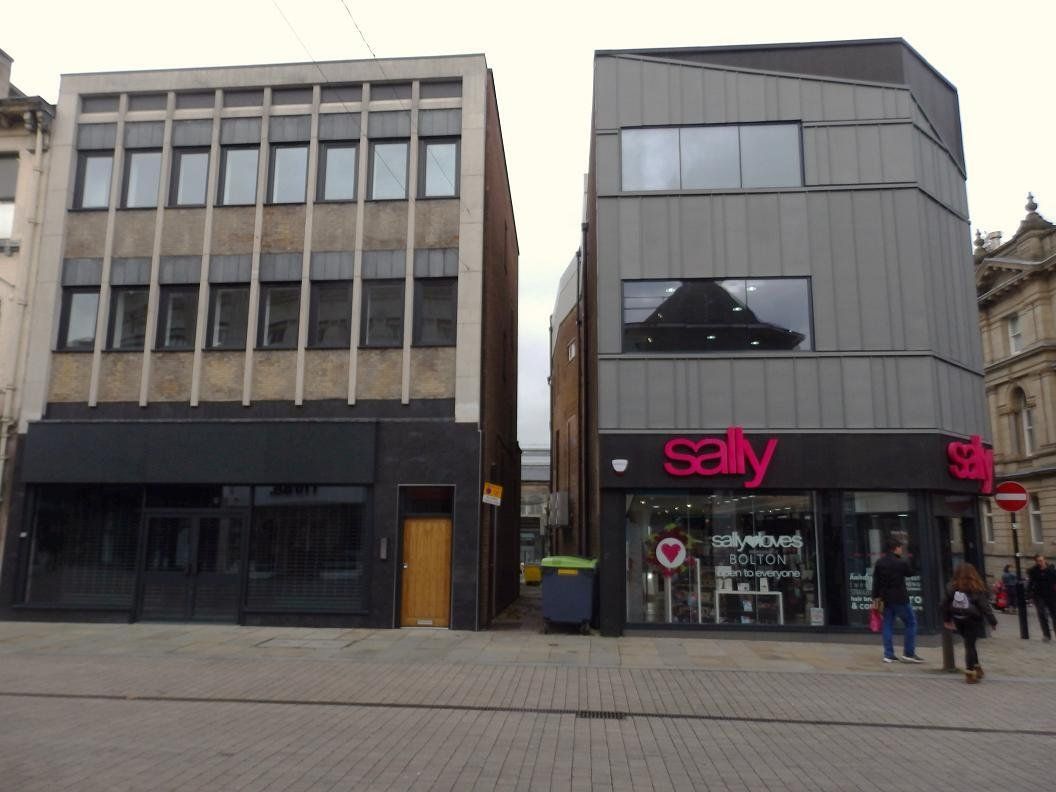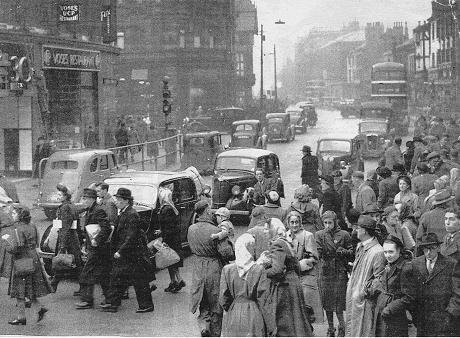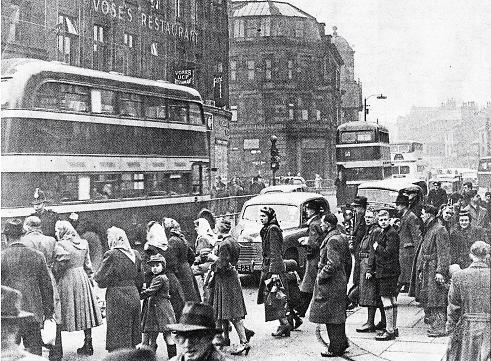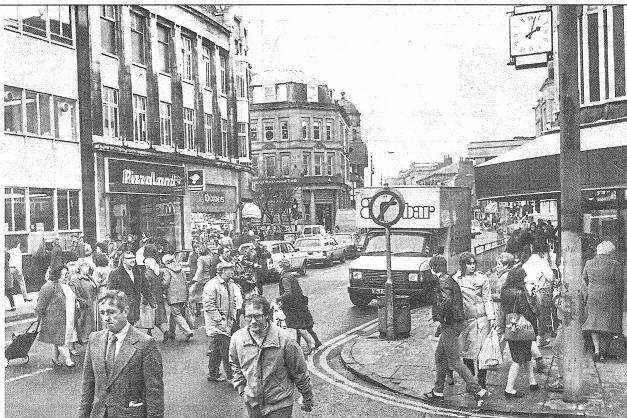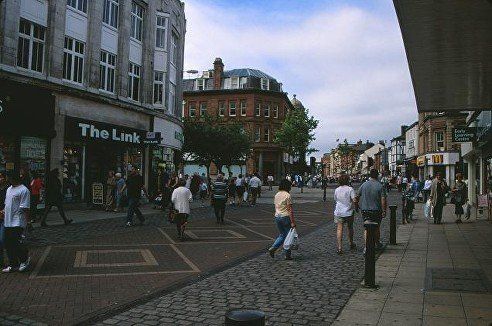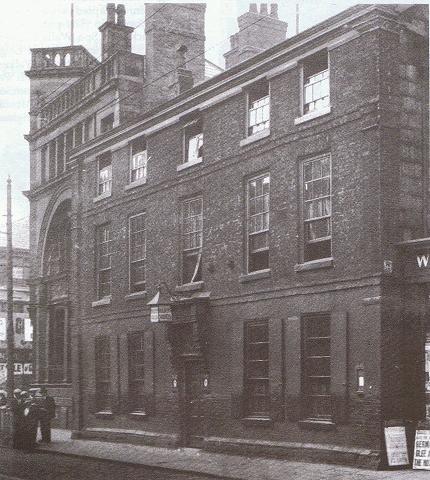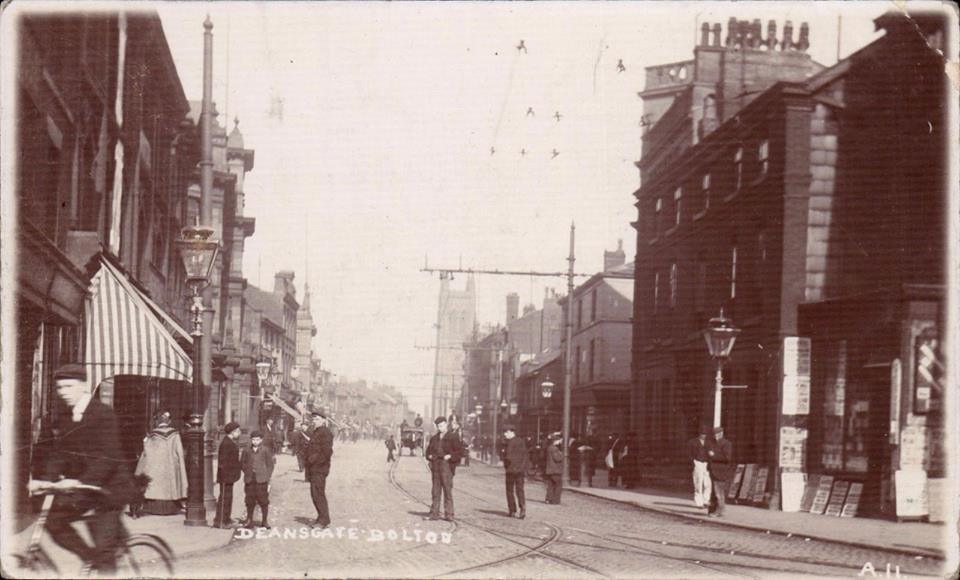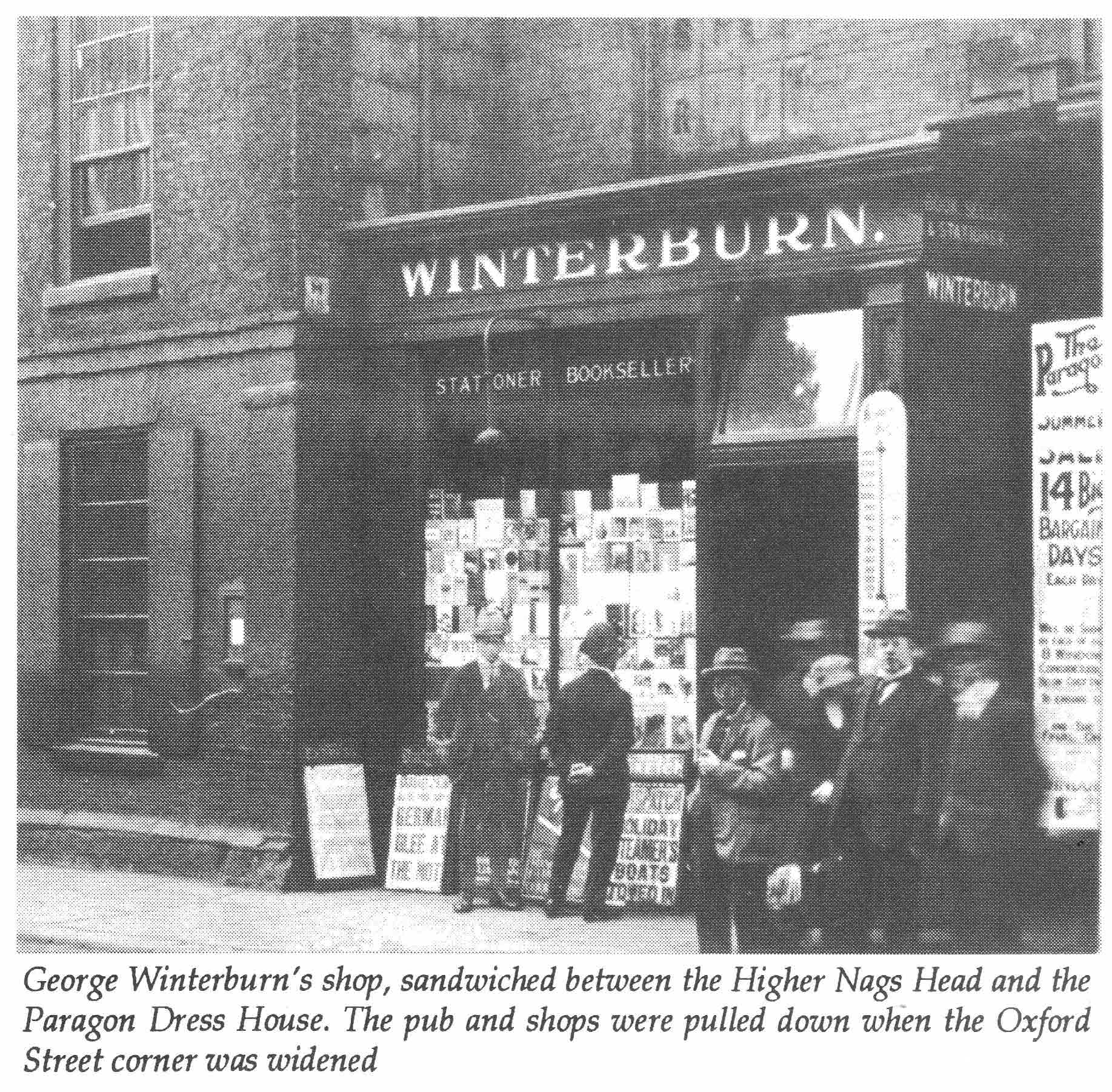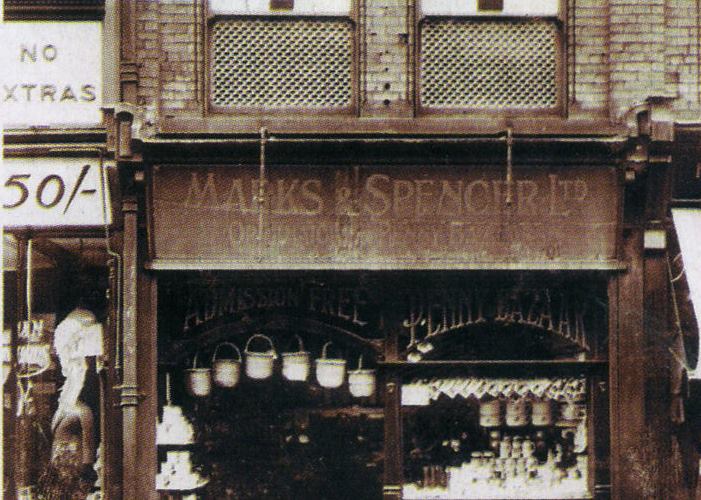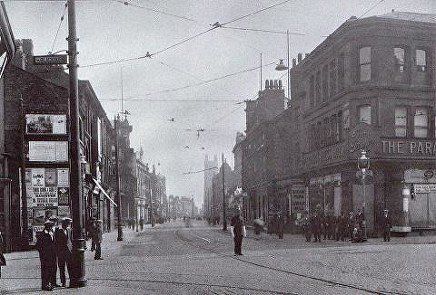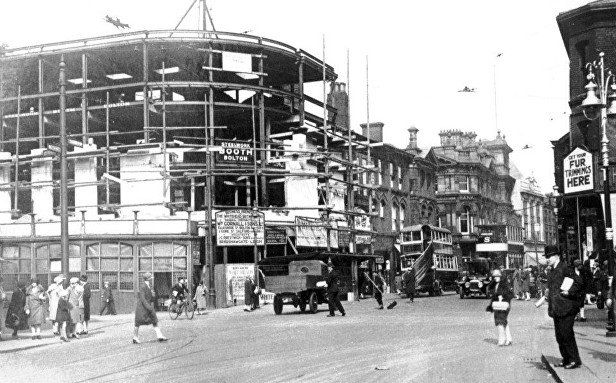20 Deansgate
from Bridge Street to Knowsley Street
This beautifully clear, wish-I-was-there picture is from David Whenlock's collection. The Electric Theatre is on the corner of Bridge Street and Deansgate with Meeson's chocolates and sweets (and port wine?) in its corner. The building with the white gable and Magees was built in 1884 and remains as the right half of Superdrug. Also still there in the present day is the Royal Bank of Scotland (or whatever its name was then and will be in the not too distant future) and the Palatine Building on the corner of Knowsley Street, still there and housing MacDonald's though now one storey lower than on this picture.. The tower of the Higher Nag's Head can be seen on the left though nothing on this side remains today.
Deansgate west of Woolworth’s. The white marble building had been Bolton’s first purpose built cinema opened 13th August 1910, originally called the Electric Theatre, then the Imperial Playhouse(1920) and finally the Embassy (probably 1936) cinema before closing in September 1947. The earliest records of films being shown in Bolton indicate the use of the Bolton Temperance Hall on St George’s Road which was later sold and used entirely as a cinema before being given a new frontage and replaced by the Rialto cinema. After the Embassy closed it became a Littlewood’s store and later rebuilt as a branch of Boots. It is now occupied by Waterstone’s book store.
To the left of the cinema we see that the building occupied by Graveson's ironmongers - note the large padlock hanging as a sign - and by Stead and Simpsons boots and shoes. Built in 1884 it is now Superdrug.
Coloured picture 24 September 2009 (C) WDC. Essentially the same view as the picture to its left. Some buildings remain. The Palatine Building (now MacDonald's) was originally one storey higher than it is today. The Royal Bank of Scotland is essentially unchanged (though it has changed its name about five times). Notice the right half of Superdrug; this building has appeared on a number of pictures having been built in 1884, the terra-cotta panels between the first and second storey windows mark it out even on the black and white pictures.
Split screen picture for comparison. The left hand part of Superdrug has been rebuilt. The large whitish building is the 1930s Knowsley House on the near corner of Knowsley Street plus a building on the corner of Market Street.
(C)WDC September 2009
From slightly further west.
The Imperial Playhouse on the corner of Deansgate and Bridge Street.
The Mystery Man (aka The Midnight Man) was made in 1919 and the first year after this in which January 18th was on a Monday was 1926, so the photo is either late 1925 or 1926. (Peter Lodge)
James J Corbett the mystery man was heavy weight boxing champion of the world , famous for winning the first ever world championship with gloves on . Otherwise known as gentleman Jim Corbett. (Tommy Battel)
The film was in 18 episodes
Bridge Street is on the left with Constantine Brothers store.
The same corner much more recently but before Deansgate was pedestrianised.
The cinema is now the Embassy - the picture has been labelled 1939 but note the film “The Green Pastures” which was released 1936. Note the shop with the terra-cotta inlays, now Boots. The tiny shop squeezed into the corner of the cinema has its name on the top blind which is not readable, but it repairs watches, clocks and jewellery. Constantine Brothers’ shop is now Woolworth’s but the statue of Britannia still graces its top. We can see the domes of Martin’s Bank and Preston’s. At this time we have trams and single and double-decker petrol buses.
1949 Deansgate looking back towards Woolworth’s before its update in the late 1950s The Electric/Embassy has not been rebuilt but is now occupied by Littlewoods. Boots is next door but one, the little jewellers shop seems still to be in place, but one of our most familiar memories of this corner is of the large Boots there until about 2004? But now multi-occupied by Waterstones and others.
One of David Whenlock's pictures.
Mid 1950s? Morris Minors appeared in 1948. Woolworth's has not altered.
This is a WOW picture! Just look at all those people! Littlewood's have now rebuilt on the Bridge Street corner.
February 1965.
Woolworth's have rebuilt. Why have they continued to differentiate between the three left windows (ex Constantine's) and the three on the right (ex Fernuhough's)?
They now have an oblique corner.
24 September 2009 (C)WDC
Superdrug is now a very large store having extended from the 1884 terra-cotta building into the later (1920s) building to its left. Waterstones Bookshop occupies the corner of Deansgate and Bridge Street.
May 2015 (C)WDC
Wilco now occupies the Woolworth’s building. Waterstones have a Costa Coffee upstairs.
11 Feb 2014 (C)WDC
Seeing this block in the opposite direction. It is actually quite a pleasant looking street.
Deansgate c1927
Corner of Mealhouse Lane with the Midland Bank
The lady at the left seems to be looking intently at the probably older lady in the long fur coat.
Posted on Facebook by Patricia Jones
Mealhouse Lane corner somewhat later.
Still the Midland Bank, Curtess Shoes, Lloyd’s, Saxone shoes, The Toggery, look at the American car.
Deansgate/Mealhouse Lane corner, roadworks July 1966. Note that the upper storey has been removed from Dunn’s.
Deansgate/Mealhouse Lane corner, roadworks 1950s.
Note Dunn’s hatters on the corner with R G Connor jeweller, silversmith and diamond merchant above.
To the right, no 37 Deansgate, memorable for its Old Mo Rum sign is George Munro’s licensed premises. This was the Bay Horse (though its name is not apparent on the pictures), one of Bolton’s oldest pubs (dating from before 1778) bought by George Monro and Co in 1865 and also known as the Scotch Vaults after George who was born 1832 in Sutherland, Scotland. George Monro represented the Exchange ward for the Liberal Party on Bolton Council from 1886 to 1889. A keen Presbyterian he was a member and generous supporter of St Andrew’s Presbyterian church on Bowker’s Row.The name George Monro seems to have been retained here even though the original George Monro died in 1894 and the company became Ross Monro. Is it possible that these premises were owned not by the Ross Monro Company but by George Monro (Junior) whose main business was in Oldham?
c1960 Dunn’s Hatters is still functioning but now has Fox’s Photographers above it and Royal Liver Assurance Offices above that. George Monro’s still appears to be in business. Marks and Spencer’s still have their original building but the premises between them and the pub have already been acquired by M&S for their expansion. Note that Dunn’s is still full height so this picture is before the 1966 road works picture above. The premises were sold to M&S in 1959 and closed in April 1960 which seems to be the latest possible date for this picture.
Spender’s Worktown photograph 1937. People outside Munro’s.
Dunn’s still in business despite having its upper storeys removed. View along Mealhouse Lane; block on right, behind Dunn’s all demolished for M&S extension
Posted on Facebook by Peter Haslam. It appears that Dunn’s has only just closed down but the M&S extension is now well under way.
Picture published by M&S
Looking along Mealhouse Lane to Dunn's.
Redesign of Woolworth's
The building of Marks & Spencer's new shop. Dunn’s still stands, still three storeys high but Ross Monro and all the other buildings around it have gone. Eventually M&S would extend to the left to the corner of Mealhouse Lane and to the right into 3/5 of the shop it is trading in at the time of this picture. Note that the two window on the right of the five were retained and are still there now. M&S now also now extends all the way back to Hotel St.
The redesign of Woolworth's which now has a diagonal corner has been completed some time previously.
Building on the other corner of Bridge Street must be the new large Boots shop, the building is still there (2021) but no longer Boots.
This is M&S somewhere between its opening in 1929 and its closing in 1967. This is how it appeared with five windows on all the previous pictures.
Now M&S has a much bigger frontage stretching from the corner of Mealhouse Lane to 3/5 the way across this building.
The part of the building containing the two right-most windows is still standing but is no longer part of M&S
This building replaced the original Nag’s Head, later called the Lower Nag’s Head, the rebuilt Lower Nag’s Head which still stands was immediately to the right, a bit of it is visible on this picture.
The main feature of this picture is the Lower Nag’s Head which was familiar through most of the 20th Century and which building still stands.
The small building to its left is the original Lower Nag’s Head which was replaced by the older Marks and Spencer’s between 1927 and 1929.
That was originally called the Nag's Head but about forty years later another pub was built further along Deansgate which was also named the Nag's Head. Lower and Higher were added to the names to avoid confusion.
The factory chimney above it belongs to the printworks on Mealhouse Lane.
Note MM (Magee Marshall) & Co at the top of the new building.
We now see the Lower Nag’s Head with the 1929 M&S building to its left and Burton’s, surprisingly built before either of them to the right. In 1967, although the pub remained open using downstairs bars, most of the ground floor became Hepworth’s Tailors and later Next. More alterations in 1982, the pub renaming itself as Oliver’s, but it closed a little while after this.
The Lower Nag's Head hosting Hepworth's in 1980
24 Sept 2009 (C)WDC
The new Marks and Spencer’s then the “To Let” shop which is the rightmost 2/5 of the original M&S,was Ladbrokes in 2019
the Lower Nag’s Head now occupied by Abbey (later Santander)
and Burtons shared with Dorothy Perkins (Utopia Women's wear in 2019).
Beyond Market Street is the Alliance and Leicester building (later Santander, now EE) which occupies the site of the Higher Nag’s Head.
Back to 1920 or just after: the block of shops which includes Burton’s on the corner of Deansgate and Market Street. The double fronted building behind the street sweeper is the Lower Nag’s Head together with the premises to the right. although details of the roof and chimney are different from the newer picture with the old and new premises (to be built in 1927).The three premises which are slightly forward of the other buildings were replaced by the new Lower Hag's Head building. The Nag's Head building on this picture and the sweet shop to its left were replaced by the M&S shop in 1929.
Burton’s has only recently been built.
Bromilow & Edwards (later Edbro) was founded in 1919.
Another picture probably taken the same day, posted on Facebook (and cleaned up?) by Peter Lodge. We see Burton’s more clearly and the Higher Nag’s Head on the other corner of Market Street.
At left we have a restaurant and cafe. It is rather surprising just how many eateries there were in Bolton c1920
May 1962 Same part of Deansgate when the circus came to town. Note Monro’s has already gone waiting for M&S redevelopment but Dunn’s still stands at its full height.
What a pity this part of Deansgate does not look like this now. This predated the building of the (now) Royal Bank of Scotland in 1875. The centre of the block, the Rope and Anchor and the two or three premises to the left of it - is now Superdrug, the red brick right half of the present building dating from 1884 and the marble style left half from the 1920s.
The caption is wrong about the Rope and Anchor. Maps show it near the centre of the block, not at the end. Moreover,compare this picture with the next two. Look at the building four windows wide to the right of "General Drapery Warehouse", then the Rope and Anchor, then the building of which you can see five windows (it has six).
On the next picture (after the constrction of the present bank building) you can see these two buildings with the 1884 building with terra-cotta inserts replacing the Rope and Anchor. To the right of these is another (unclear) small building.
Coloured picture - the 4-window building is still there. The 6-window building has gone.
On present day pictures (up the page) the Boots / Waterstones building is to the right of the 1884 building and is on the corner of Bridge Street - so that building has replaced the 6-window building and whatever may have been to its right disappeared with the widening of Bridge Street.
The Bolton News dates this picture as “in the 1890s”. We do not yet have electric trams (c1900). We see William’s Deacon’s Bank, the red brick (or terra cotta) building of 1884 is there. The white building to its left is clearly the two shop premises to the left of the Rope and Anchor on the previous picture and was replaced in the 1920s. The statue of Britannia (which was removed in 1942) on the Constantine Brothers building (later Woolworth’s, now Wilkinson’s) stands clear and proud.
A familiar picture that has appeared in a number of guises. This is a hand coloured black and white photo published as a postcard. The figure in the window of the Bank is perhaps in a maid’s dress but in other versions of this picture the figure looks more like a table lamp. The tram has been imaginatively coloured in Glasgow livery. We have electric trams so the picture is after 1900. It appears that the Electric Theatre on the corner of Bridge Street is being built which would date the picture to c1909.
Picture from David Whenlock’s collection.
Deansgate from the corner of Knowsley Street.
The Bank (1875) is on the left.
The Higher Nag’s Head
http://lostpubsofbolton.blogspot.co.uk/2014/10/higher-nags-head-holdens-vaults.html
is on the right but the cathedral-like building on the corner of Market Street has not yet been built. This is before electric trams so is between 1875 and 1900. Magees closed it in 1929 after rebuilding the Lower Nag’s Head in 1927.
The shop with the name starting R. SH is on the corner of Market Street. This building appears on the next picture though under different ownership.
Picture posted on Facebook by Gene Watts.
Deansgate to the left of the corner, Market Street to the right. The Gas Offices tower on Hotel Street can be seen.
57 and 59 Deansgate, Shaw Sturges and Co, Gents outfitters, Hosiers and Glovers, General Drapers and Silk Mercers, Ladies Outfitters and ???? - apparently known as Bolton Glovers.
Burtons was built on this corner.
Date not known. Woolworth's has its diagonal corner, Boots is there, all buildings are as at present except Barclay's Bank on near corner of Market Street.
Williams Deacons seen from Market Street (South), built 1875. Origins in 1818 in Water Street, later Grapes Hotel, moved to Market Street as Hardcastle Cross and co . 1890 Williams Deacons and Manchester and Salford Bank, c1901 Williams Deacons. 1925 extended. 1970 Williams and Glyns. Then Royal Bank of Scotland. RBS is to be broken up after its part in the credit crunch and this branch will revert to Williams Glyns in 2016. This process has gone slowly and is unlikely to be completed in 2017. Still RBS in 2021.
1960s? Pizzaland on the corner of Market Street, opposite Royal Bank of Scotland.
Sally in 2019
And diagonally across from Royal Bank was Barclays in the 1960. Picture posted on Facebook by Peter Lodge.
Market Street from Deansgate to the Market Hall with Royal Bank of Scotland on the right.
23 May 2016 (C)WDC
Market Street from Deansgate to the Market Hall with Royal Bank of Scotland on the right. The buildings on the right are unchanged. On the left the building on the bottom corner is essentially unchanged but the top half of the street is very different even if only superficially.
May 1965. A look up Market Street towards Deansgate and on to Hotel Street in the far distance. The sheets around RBS are probably for cleaning. Burton’s remains as we always remember it. Although the modern canopy has been added to the corner shop on the right the building has not been changed
That same corner of the bank building, 36 Market Street with Lorne Street running off to the left.
Who would have guessed?
Picture posted on Facebook by Gene Watts.
Recent picture of that corner from Google Street View.
1950
Millwell Lane from Corporation Street to Deansgate. An old map shows Millwell Lane continuing in a bendy fashion towards the River Croal. The well is marked in a position just this side of the middle of the Market Hall. At the far end of the lane across Deansgate is the Higher Nags Head.
December 1949
A very busy Deansgate at its junction with Oxford Street on the left and Knowsley Street on the right. And the same place a few seconds later. Can you see anyone on both pictures?
One person on the second picture has noticed the photographer.
Quite a few trilbies on the men and no flat caps.
But what a lot of headscarves on the women.
1984 much more informal dress, still one headscarf.
Same corner in 1998 – pedestrianised, much less busy.
MacDonald's is on the Knowsley Street corner by this date.
(C)WDC
We go back 100 years and 30yards to the left hand end of the block containing LINK.
The Higher Nags Head pictured a few years before it closed in 1929. Image from the Bolton Library And Museums Service collection. Copyright Bolton Council.
The very grand building is on the corner of Market Street where Alliance and Leicester had a new building (taken over by Santander and now EE). The arch is what could be seen in the view up Millwell Lane.
The main part of the picture is the Higher Nag’s Head taking up most of that block between Market Street and Oxford Street. IT IS NOT CLEAR whether the building on the corner was part of the Higher Nag’s Head or whether it was something else. It seems to have been built further back than the pub as if in anticipation its demolition and the widening of Deansgate. At the extreme left we see across Market Street to Burton’s or whatever preceded it.
The following text is from the Lost Pubs of Bolton web-site.
The building was a private residence for some years before becoming a pub. It was built in 1735 as a townhouse for John Andrews (1684-1743). Andrews’ principle residence was Rivington Hall, which he bought from the Breres family in 1729 but he needed a residence in the centre of town.
Andrews was famous for having built the beacon on top of Rivington Pike in 1733.
Around 1820 the house became licensed premises. For a number of years people differentiated between the two pubs (this one and the Nag's Head, later Lower Nag's Head) by referring to the Higher Nags Head as Holden’s Vaults. That was after John B Holden and Co, a firm of wine and spirit merchants who owned the pub and used it to store their stock.
Looking back again towards RBS and the Parish Church. An atmospheric picture full of interest.
Electric trams, horse and cart, man enquiring of the policeman (or is it two bobbies having a confab?), The Upper Nag’s Head, closed in 1929 is still there and the 1930-32 building on the corner of Knowsley street has not commenced building. Burton’s is not yet there. Picture probably c1920.
Knowsley Street is on the left and Oxford Street is on the right with pavements and tram lines curving into both.
A David Whenlock postcard.
Not a lot different. We seem to have someone in a clerical cope at left. On the right we see more clearly Winterburn's booksellers that was to the right of the Higher Nag's Head on an earlier picture with a name beginning with W.
On this picture Winterburn's is the feature. Advertised as Bookseller and Stationer. Note the large Stephenson's Ink advertising thermometer.
Marks and Spencer c1915 at 60 Deansgate that is next door to the shop on the corner of Knowsley Street (next door to what is now Gregg's)
Admission free
Penny Bazaar
Deansgate looking east towards the Parish Church with Oxford Street on the right, The Paragon on the corner and Knowsley Street on the left, signposted to Blackburn.
Between the Paragon and the Higher Hag's Head, the newsagents we saw previously (probably also a stationers and booksellers) advertises Swan pens and ink.
On the left Royal Bank of Scotland (or whatever it was called at this date) Britannia on the roof of Constantine Brothers (Woolworths) then buildings on Churchgate with the Market Cross and the Church tower.
Date between 1913 and 1930ish when this corner was redeveloped, probably mid 20s but might be determined by when Thomas Cook moved to 9 Victoria Square. (They were not there on a picture of a charabanc trip c1920.) Domed building on right makes this picture slightly later than the one two above.
Corner of Deansgate (into the picture) and Knowsley Street (to the left) c1929-32
Knowsley House (the building which is still there) is under construction. It was owned by Whiteheads and replaced older properties including the Bolton Corporation tram waiting room which probably still exists as the framework at bottom left.
The tram is route S for Church Road and Elgin Street. This route was discontinued 1st Mar 1933 the service being replaced by a motor bus.
Is the man with a broom simply carrying it and is coincidentally crossing the road, or is he a "crossing sweeper" there to sweep up after any horse drawn traffic.
Next page we travel up Knowsley Street.

